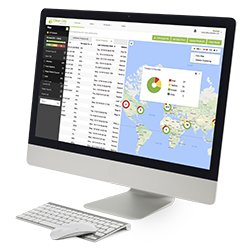It is safe to say that every company wants to run their daily operations as efficiently as possible. When it comes to collecting urban waste, the traditional way of improving performance has been to analyze waste generation and population data in each neighborhood, and then roughly optimize the collection routes and schedules based on the calculations. While this methodology might offer some rough indication on where waste collections are needed, it does not prevent the collection trucks from collecting nearly empty bins along the route, and neither does it detect overflowing waste containers.
The 21st-century solution to this problem has been to install a wireless fill-level sensor in each waste container and monitor the fill-levels in real time through a data analytics platform. The solution has been already installed in tens of thousands of waste bins around the world, and it offers valuable information for route optimization especially in the case of large containers with significant distances in between. Although the technology is already offered by numerous solution providers worldwide, most of the software platforms out there have a major shortcoming: their route optimization algorithms consume only real-time data.
Why real-time data can be impractical in urban route optimization
The main problem of optimizing waste collection routes in urban locations with real-time data is that although the number of collections is likely to decrease, the number of dispatches is likely to increase – resulting in higher operational costs. For example, if you send out a collector to collect bins that are currently full, but by the time they return to the depot, if another bin becomes full, you would have to dispatch another collection.
Another problem with route optimization using only real-time data is that the solution cannot prevent waste overflow during off-hours. Once the collection truck finishes its last collection route of the day, the waste containers keep filling up and some will eventually overflow before the next morning.
The power of combining real-time data with predictive analytics
 To eliminate unnecessary dispatches, the key is to include predictive analytics inside the route optimization algorithm. By analyzing each unique waste container’s historical fill-level data from the past months, the algorithm is able to forecast the hourly fill-level increase of each bin specifically for each day and time. As a result, the waste collection operators can make data-driven decisions ahead of time by including the bins that are soon becoming full into their collection routes, saving both time and money.
To eliminate unnecessary dispatches, the key is to include predictive analytics inside the route optimization algorithm. By analyzing each unique waste container’s historical fill-level data from the past months, the algorithm is able to forecast the hourly fill-level increase of each bin specifically for each day and time. As a result, the waste collection operators can make data-driven decisions ahead of time by including the bins that are soon becoming full into their collection routes, saving both time and money.
As an example, imagine that a waste collection truck is dispatched four times a day (9 am, 12 pm, 3 pm, 6 pm), and a certain street has three bins to collect. The predictive algorithm knows that the containers’ fill-levels increase at the speed of 10% per hour, and at 9 am it checks the real-time fill-levels which appear to be 10%, 40%, and 70%. Knowing this information, the software forecasts that it’s better to postpone collecting the bins until 12 pm when the fill-levels are likely to be 40%, 70%, and 100%. Once the truck arrives at 12 pm, the algorithm tells the operator to collect the bins which are 70% and 100% full. By doing so, the truck does not need to return to the same street again until 6 pm, when the bins are 100%, 60% and 60% full. This time the algorithm asks the operator to collect all three bins, because it knows that during off-hours the 60% full bins would overflow, although their fill-level increase at night time is only 5% per hour.
If the same truck would have collected the bins using only real-time fill-level information, it would have visited the same street on each of the four dispatches, and during night time, two of the three bins would have overflown.
The leading provider of fill-level forecasting
If you are interested in learning more about how predictive analytics could improve your waste collection efficiency, and run a pilot project, please contact Ecube Labs. Our integrated waste management solution includes ultrasonic fill-level sensors, solar-powered waste compacting bins, and a SaaS platform, which brings together waste container monitoring, data analytics, and fill-level forecasting. As an added benefit, the platform also provides consultation on bin allocation. Altogether our solution can improve your operational waste collection efficiency by up to 50%.
